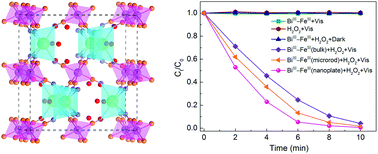Structure and excellent visible light catalysis of Prussian blue analogues BiFe(CN)6·4H2O†
Abstract
Photo-Fenton catalysis with high-efficiency is required for the resolution of environmental pollution. Here, the Prussian blue analogue BiFe(CN)6·4H2O with a narrow bandgap (1.63 eV) shows excellent visible light catalysis to decompose organic dyes and tetracycline. The microrod and nanoplate morphologies were successfully synthesized by simple precipitation with different additives. The nanoplates of BiFe(CN)6·4H2O show excellent phono-Fenton catalytic activity meaning that RhB can be decomposed within 6 min in the presence of H2O2. BiFe(CN)6·4H2O exhibits a layered structure, which consists of FeC6 and BiN6 coordination polyhedra. The zero field cooling indicated that BiFe(CN)6·4H2O has an antiferromagnetic order at low temperatures. Furthermore, the stability of the BiFe(CN)6·4H2O catalyst is very good, which has been investigated by various characterizations. The mechanism of the excellent catalysis is related to the crucial role of H2O2, which inhibits the recombination of the electron–hole pair and drives the photo-Fenton reaction. Therefore, to treat the wastewater by photo-Fenton catalysis, the present component of BiFe(CN)6·4H2O is a promising catalyst candidate.

- This article is part of the themed collection: Inorganic Chemistry Frontiers HOT articles for 2018


 Please wait while we load your content...
Please wait while we load your content...